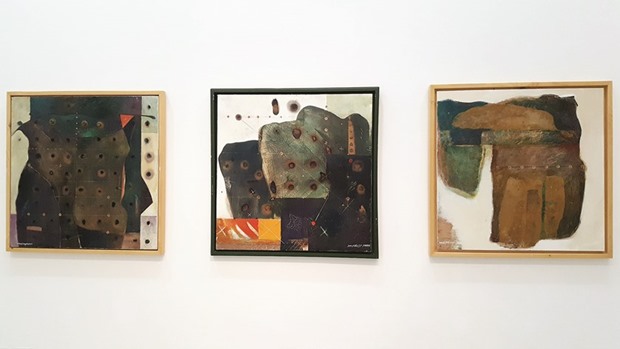Al-Markhiya has put together an inspiring mix of old and new works from both established and up-and-coming names in the local and regional art scene at their ongoing exhibition.
Up on display at the Katara Art Centre Gallery are the works of painting and sculptures from artists based in Doha.
Faraj Daham, a veteran Qatari artist, is one of them. He is showcasing mixed media on wood titled ‘Movement’. The three paintings, displaying intense colour patterns spread over canvases, are from Daham’s 2001 collection.
Daham’s experience is intricately linked to the movement of organic bodies. He worked for a very long time on rendering images and showcasing them in a single space condensed by both action and reaction, while portraying bodily energy in a manner that captures the essence of its potential to change.
Faraj Daham directly worked on capturing the fragmentation and decay that affects bodies, which are always tormented, and on searching for the appropriate artistic equivalent for rearranging organic entities.
He plots the way forward as an observer and as an artist with his imagination, and power of deduction, to find the best method to reconstitute the body. He believes that there are motives harboured by the latter, like a power charge inherent in human action. In fact, this is the very scale upon which we can build our knowledge of the artist’s path since 1975.
Faraj was preoccupied as a researcher with the idea of organic transformations in nature, and their outcomes that continuously build and rebuild themselves. These transformations have evolved, while he continues to draw on social, technological, ecological and universal changes.
Daham believes that all these transformations affect the body and its abilities, and influence the path of its spontaneous growth.
In general, his method is observation. Daham explores his surroundings to record the metamorphosis of individuals and groups, as bodies vacillate among laws, equations, rules and barriers that restrict motion, and obstruct one’s path, altering the trajectory of the body’s motion.
And this Faraj examines closely to learn about the body’s ability to endure, and achieve equilibrium and stability in an existence that is rapidly becoming universal, and which dictates to us the conditions of our survival.
This contemporary but ever-changing modernist sense of empowerment did not prevent Faraj Daham from dealing with the notion of the body with a mentality that is not completely detached from today’s realities.
Scientific and empirical principles and discoveries are denotative signs that instruct the artist to look for co-ordinates and paths that reorganise the overall composition of works of art, while the return to scientific and philosophical principles and biological diversity makes room for knowledge and reasoning.
With the presence of the body in its stationary and mobile forms in spaces of criss-cross lines and geometrical shapes, Faraj uses colour synthesis to contain the visual medium away from superfluous aesthetics on the painting’s surface.
The overall configuration of Faraj Daham’s artistic work is ever-growing, touching on other diverse artistic mediums, such as drawing, painting, sculpture-and pottery, as well as collages and other new techniques that he continuously explores in his workshop.
The result, after his long journey, is that Daham continues to be aware of the connection between people and their suffering. He draws a path from yesterday, to today, or a path between arrival and departure, and between wherever places the human body goes to in our world.
Born in Doha in 1956, Daham pursued his Bachelors degree in the Higher Institute of Theatric Arts in Kuwait between 1980 and 1984.
In 1986, he continued his education to graduate in 1988 with a Masters degree in Fine Arts from Ball State University, USA.
Daham’s aptly succeeded in capturing the imagination of both Qatari and international audiences and has won many prestigious awards. His work is held in numerous public and private collections throughout the world.
Showcasing with him is Iraqi-British artist Sabah Arbilli who is now based in Doha. The three sculptures of Arbilli on display portray his signature combination of calligraphy with metal done in intricate designs. Comparatively smaller in size to some of his previous ones, Sabah likes to work with life-size sculptures.
One of his masterpieces is installed on the Corniche in Doha, with many of his sculptures installed at many popular places in the world. Among other artists displayed at the exhibition are Islam Kamil from Sudan, Mohammed al Wahibi from Palestine, Khaled Farhan from Bahrain, Ebtisam al-Saffar from Qatar, and Hussein Madi from Lebanon.

ON DISPLAY: The ‘Movement’ by Faraj Daham, mixed media on wood.


